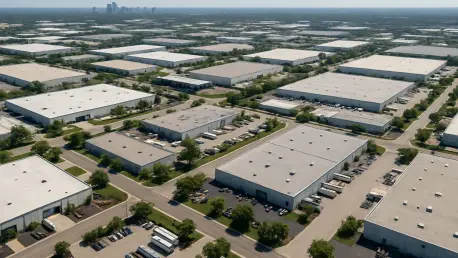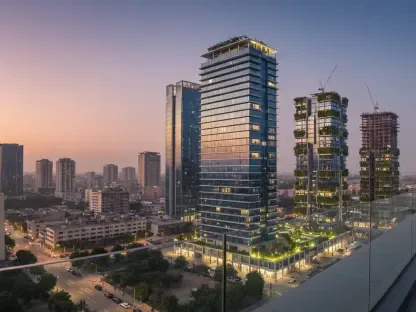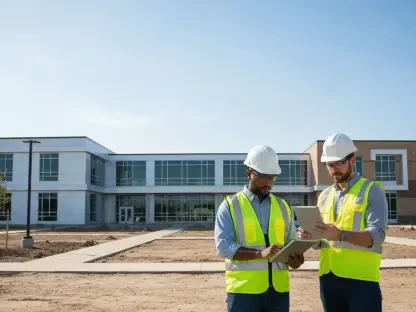The industrial real estate sector in the United States stands at a critical juncture in the first half of this year, as a notable national slowdown in deliveries contrasts sharply with impressive growth in select metropolitan areas. Despite a 35 percent decline in completed industrial space compared to last year—dropping from 228.3 million to 149.3 million square feet—certain markets are defying the trend and emerging as leaders in development. This analysis focuses on five key metros—Phoenix, Kansas City (Mo.), Philadelphia, Dallas, and Houston—that have recorded the highest industrial space deliveries during this period. Backed by insights from Yardi Research, the exploration reveals how these areas are navigating economic headwinds like tighter financing and rising vacancy rates while leveraging unique strengths. From strategic slowdowns to unexpected surges, the dynamics of industrial growth are reshaping the landscape, offering a glimpse into the future of logistics and supply chain infrastructure across the nation.
Powerhouses in Focus: Phoenix and Dallas
In Phoenix, the industrial market leads with a substantial 11.2 million square feet delivered across 52 projects during the first half of this year, though this figure reflects a decline from the 19.6 million square feet completed in the same period last year. Developers in this metro appear to be adopting a deliberate strategy, pacing completions to match tenant absorption rates and prevent oversupply, especially as vacancy rates have edged upward. Despite the slowdown, Phoenix’s long-term appeal remains strong, driven by its strategic proximity to Southern California markets and a business-friendly tax environment. A robust pipeline further supports this optimism, with 16.8 million square feet currently under construction and an additional 39 million square feet in the planning stages. This balance of caution and forward-thinking investment underscores Phoenix’s position as a dominant player in the industrial sector, adapting to current challenges while preparing for sustained demand in the coming years.
Dallas, another titan in the industrial space, recorded 8.7 million square feet of deliveries in the first half of this year, marking a significant drop from the 19.6 million square feet seen in the prior year. However, this reduction signals a temporary pause rather than a retreat, as the metro maintains the largest national pipeline with 30.8 million square feet under construction. The city’s robust infrastructure, coupled with a pro-business climate, continues to attract substantial investment, even amidst economic uncertainties and tighter capital markets. Developers in Dallas are strategically recalibrating, focusing on absorbing existing inventory before ramping up new completions. This measured approach highlights a broader trend among established markets, where short-term caution paves the way for long-term stability. As a logistics hub with unparalleled connectivity, Dallas remains a cornerstone of industrial real estate, poised to capitalize on future growth driven by e-commerce and supply chain optimization.
Emerging Contenders: Kansas City and Philadelphia
Kansas City (Mo.) has emerged as an unexpected powerhouse, achieving a staggering 260 percent increase in industrial deliveries, reaching 10.6 million square feet in the first half of this year. This secondary market’s rapid ascent can be attributed to its central geographic position, providing access to critical national freight corridors, alongside the availability of affordable land that lowers development costs. Unlike more speculative markets, Kansas City’s growth appears largely demand-driven, with minimal overbuilding, as evidenced by a relatively modest pipeline of future projects. The metro’s rise reflects a broader shift in the industrial landscape, where cost-effective alternatives to traditional hubs are gaining traction among developers and tenants alike. As supply chain strategies evolve to prioritize efficiency and proximity, Kansas City stands out as a compelling option, offering a balance of accessibility and economic advantage that could redefine regional logistics priorities.
Philadelphia, too, has captured attention with a remarkable fourfold surge in industrial deliveries, totaling 9 million square feet in the first half of this year. Positioned near major Northeast ports and population centers, the metro is becoming a vital logistics hub, fueled by escalating demand for e-commerce fulfillment and specialized facilities like cold storage. Despite this impressive growth, slower construction starts suggest potential hurdles, such as permitting delays or other regulatory bottlenecks, which could temper future momentum. Philadelphia’s transformation into a key player underscores the growing importance of regional advantages in industrial development, particularly in densely populated areas where last-mile delivery needs are intensifying. As developers navigate these challenges, the metro’s strategic location positions it to meet evolving market demands, signaling a shift in focus toward underutilized markets with untapped potential for logistics and warehousing expansion.
Consistent Performer: Houston’s Stable Expansion
Houston has maintained a steady presence among the top industrial markets, delivering 8.1 million square feet in the first half of this year while showing an uptick in construction starts. Anchored by access to major ports, a strong energy sector, and a rapidly growing population, the metro offers a solid foundation for sustained industrial growth. Unlike some markets experiencing dramatic fluctuations, Houston’s balanced approach—avoiding both overextension and sharp pullbacks—demonstrates a quiet confidence in meeting future demand. This stability is particularly significant in a national climate of economic uncertainty, where developers are grappling with higher interest rates and tighter financing conditions. Houston’s ability to maintain consistent progress highlights its role as a dependable hub for industrial activity, supported by diverse economic drivers that ensure resilience even as other regions recalibrate their strategies for the shifting landscape.
Looking deeper into Houston’s performance, the metro’s industrial expansion is bolstered by its integration into global trade networks through port connectivity, which facilitates the movement of goods amid ongoing supply chain realignments. Additionally, the energy sector’s influence provides a unique economic buffer, attracting businesses that require specialized industrial spaces. The growing population further fuels demand for warehousing and distribution facilities to support consumer markets. While not as flashy as the surges seen in emerging markets, Houston’s steady momentum reflects a pragmatic approach to development, prioritizing long-term viability over short-term gains. This consistency positions the metro as a critical node in the national industrial framework, capable of adapting to broader trends like reshoring and e-commerce growth without succumbing to the volatility affecting other regions. Houston’s story is one of understated strength, offering a model for sustainable progress in a complex market environment.
Reflecting on Market Dynamics and Future Pathways
Reflecting on the industrial real estate landscape in the first half of this year, the achievements of Phoenix, Dallas, Kansas City, Philadelphia, and Houston paint a picture of a sector navigating both challenges and opportunities with varied strategies. Each metro adapted to national trends—such as the significant decline in overall deliveries—by leveraging localized strengths, whether through strategic pacing, unexpected growth, or steady expansion. The diversity in their approaches, from cautious recalibration in established hubs to bold surges in secondary markets, illustrates the resilience and adaptability that define the industry during this period. Economic headwinds like rising interest rates tested developers’ resolve, yet the substantial pipelines of planned and under-construction projects across these areas signal enduring confidence in the sector’s potential.
Looking ahead, stakeholders can draw valuable lessons from these leading metros to inform future industrial development. Prioritizing alignment between supply and tenant demand, as seen in Phoenix and Dallas, could mitigate risks of oversupply in other regions. Simultaneously, investing in emerging markets with untapped advantages, similar to Kansas City and Philadelphia, might uncover new growth opportunities for logistics and warehousing needs. For stable markets like Houston, maintaining a balanced approach could serve as a blueprint for weathering economic fluctuations. As supply chain dynamics continue to evolve with e-commerce expansion and reshoring initiatives, focusing on strategic locations and infrastructure will be paramount. These insights offer a roadmap for developers and investors to navigate the next phase of industrial growth, ensuring that the sector remains a cornerstone of economic progress in the years ahead.









